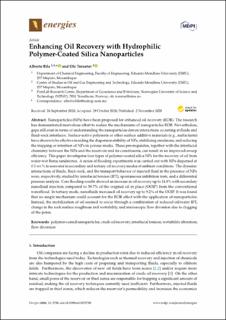| dc.contributor.author | Bila, Alberto Luis | |
| dc.contributor.author | Torsæter, Ole | |
| dc.date.accessioned | 2022-05-04T09:12:38Z | |
| dc.date.available | 2022-05-04T09:12:38Z | |
| dc.date.created | 2020-11-02T09:45:41Z | |
| dc.date.issued | 2020 | |
| dc.identifier.citation | Energies. 2020, 13 (21), 1-15. | en_US |
| dc.identifier.issn | 1996-1073 | |
| dc.identifier.uri | https://hdl.handle.net/11250/2994076 | |
| dc.description.abstract | Nanoparticles (NPs) have been proposed for enhanced oil recovery (EOR). The research has demonstrated marvelous effort to realize the mechanisms of nanoparticles EOR. Nevertheless, gaps still exist in terms of understanding the nanoparticles-driven interactions occurring at fluids and fluid–rock interfaces. Surface-active polymers or other surface additive materials (e.g., surfactants) have shown to be effective in aiding the dispersion stability of NPs, stabilizing emulsions, and reducing the trapping or retention of NPs in porous media. These pre-requisites, together with the interfacial chemistry between the NPs and the reservoir and its constituents, can result in an improved sweep efficiency. This paper investigates four types of polymer-coated silica NPs for the recovery of oil from water-wet Berea sandstones. A series of flooding experiments was carried out with NPs dispersed at 0.1 wt.% in seawater in secondary and tertiary oil recovery modes at ambient conditions. The dynamic interactions of fluids, fluid–rock, and the transport behavior of injected fluid in the presence of NPs were, respectively, studied by interfacial tension (IFT), spontaneous imbibition tests, and a differential pressure analysis. Core flooding results showed an increase in oil recovery up to 14.8% with secondary nanofluid injection compared to 39.7% of the original oil in place (OOIP) from the conventional waterflood. In tertiary mode, nanofluids increased oil recovery up to 9.2% of the OOIP. It was found that no single mechanism could account for the EOR effect with the application of nanoparticles. Instead, the mobilization of oil seemed to occur through a combination of reduced oil/water IFT, change in the rock surface roughness and wettability, and microscopic flow diversion due to clogging of the pores. | en_US |
| dc.language.iso | eng | en_US |
| dc.publisher | MDPI | en_US |
| dc.relation.uri | https://www.mdpi.com/1996-1073/13/21/5720/pdf | |
| dc.rights | Navngivelse 4.0 Internasjonal | * |
| dc.rights.uri | http://creativecommons.org/licenses/by/4.0/deed.no | * |
| dc.title | Enhancing oil recovery with hydrophilic polymer-coated silica nanoparticles. | en_US |
| dc.title.alternative | Enhancing oil recovery with hydrophilic polymer-coated silica nanoparticles. | en_US |
| dc.type | Peer reviewed | en_US |
| dc.type | Journal article | en_US |
| dc.description.version | publishedVersion | en_US |
| dc.source.pagenumber | 1-15 | en_US |
| dc.source.volume | 13 | en_US |
| dc.source.journal | Energies | en_US |
| dc.source.issue | 21 | en_US |
| dc.identifier.doi | 10.3390/en13215720 | |
| dc.identifier.cristin | 1843996 | |
| dc.relation.project | Norges forskningsråd: 262644 | en_US |
| cristin.ispublished | true | |
| cristin.fulltext | original | |
| cristin.qualitycode | 1 | |

